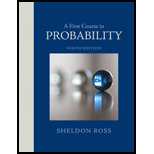
Use the rejection method with
Want to see the full answer?
Check out a sample textbook solution
Chapter 10 Solutions
A First Course in Probability
- Theorem 2.4 (The Hölder inequality) Let p+q=1. If E|X|P < ∞ and E|Y| < ∞, then . EXY SEXY ≤ Xp Yq.arrow_forward2 P(x,y). kx²y X: 1,2 5.11273 Find k Find P(x/y) ③ Mxy Ng q oxy วarrow_forwardThe joint density function of two continuous random variables X and Y is: p(x, y) = {Kcos(x + y) Find (i) the constant K 0 0arrow_forwardp(x,y) = {e-x -(x+y) 0 x ≥ 0, y ≥ 0 otherwise find x,y,Exy, by Охarrow_forwardIf X is a continuous random variable having pdf as shown. Find a) the constant k b) P(X>1) c) X, X², 0%, standard deviation. n(x) k -2 -1 0 1 2arrow_forwardThe joint probability function for the random variables X and Y is y 0 1 2 P(X, Y) = x0 [3/28 9/28 3/281 = 13/14 3/14 2 1/28 0 0 0 Find Mx, My, E(XY), OXY.arrow_forwardP(x, y) = {e-(x+y) x≥0, y ≥0 0 otherwise find x, y, x,y JX, 4 буarrow_forwardThe joint density function of two continuous random variables X and Y is: p(x, y) = {Kcos(x- Find (i) the constant K + y) 0 0arrow_forwardA random variable X has a Gaussian distribution. The mean value of X is 2 and the variance is 4 volts. Compute the following probabilities: a) P(X3) c) P(X<-2) d) P(2arrow_forwardLet X and Y be random variables having joint density function 0≤x≤1,0≤ y ≤ 1 find X, Y, 0, 0, OXY otherwise p(x,y) = {x+yarrow_forwardFind the probability in tossing a fair coin three times, there will appear a) 3 H b)2 H 1T c) 2 T and 1 H d) 3 T.arrow_forwardLet the random variable X represents the number of automobiles that are used for different business purpose on any given workday. Xi p(xi) 1 0.3 Find: a) μx b)X2 c) o 2 2 3 0.4 0.3arrow_forwardarrow_back_iosSEE MORE QUESTIONSarrow_forward_iosRecommended textbooks for you
 College Algebra (MindTap Course List)AlgebraISBN:9781305652231Author:R. David Gustafson, Jeff HughesPublisher:Cengage LearningAlgebra & Trigonometry with Analytic GeometryAlgebraISBN:9781133382119Author:SwokowskiPublisher:Cengage
College Algebra (MindTap Course List)AlgebraISBN:9781305652231Author:R. David Gustafson, Jeff HughesPublisher:Cengage LearningAlgebra & Trigonometry with Analytic GeometryAlgebraISBN:9781133382119Author:SwokowskiPublisher:Cengage Linear Algebra: A Modern IntroductionAlgebraISBN:9781285463247Author:David PoolePublisher:Cengage Learning
Linear Algebra: A Modern IntroductionAlgebraISBN:9781285463247Author:David PoolePublisher:Cengage Learning
 College Algebra (MindTap Course List)AlgebraISBN:9781305652231Author:R. David Gustafson, Jeff HughesPublisher:Cengage LearningAlgebra & Trigonometry with Analytic GeometryAlgebraISBN:9781133382119Author:SwokowskiPublisher:Cengage
College Algebra (MindTap Course List)AlgebraISBN:9781305652231Author:R. David Gustafson, Jeff HughesPublisher:Cengage LearningAlgebra & Trigonometry with Analytic GeometryAlgebraISBN:9781133382119Author:SwokowskiPublisher:Cengage Linear Algebra: A Modern IntroductionAlgebraISBN:9781285463247Author:David PoolePublisher:Cengage Learning03a: Numerical Differentiation Review; Author: Jaisohn Kim;https://www.youtube.com/watch?v=IMYsqbV4CEg;License: Standard YouTube License, CC-BY
Linear Algebra: A Modern IntroductionAlgebraISBN:9781285463247Author:David PoolePublisher:Cengage Learning03a: Numerical Differentiation Review; Author: Jaisohn Kim;https://www.youtube.com/watch?v=IMYsqbV4CEg;License: Standard YouTube License, CC-BY
